Hydrocarbon Generation and Accumulation in the Eastern Kuqa Depression, Northwestern China: Insights from Basin and Petroleum System Modeling
Abstract
1. Introduction
2. Geological Setting
3. Materials and Methods
3.1. Restoration of the Tectonic Evolution
3.2. Two-Dimensional Basin Modeling of an Extruded Structural Section
3.2.1. ‘Block’ Definition and Subdivision
3.2.2. Input Parameters
4. Results
4.1. Tectono-Sedimentary Evolution of the Eastern Kuqa Depression
4.2. Thermal and Maturity History of the Eastern Kuqa Depression
4.3. Hydrocarbon Generation History of the Eastern Kuqa Depression
5. Discussion
5.1. Comparisons of Hydrocarbon Generation
5.1.1. Hydrocarbon Generation in Different Geological Periods
5.1.2. Hydrocarbon Generation in Different Zones
5.1.3. Hydrocarbon Generation in Different Strata
5.1.4. Hydrocarbon Generation of Different Lithologic Source Rocks
5.2. Migration and Accumulation Process
5.3. Prediction of Oil and Gas Accumulation
6. Conclusions
- (1)
- Thermal anomalies are caused by extrusion thrust, the plastic deformation of gypsum–salt rock, and rapid deposition or erosion in the Kuqa Depression, all of which have had a significant influence on the heat flow and source rock maturity evolution history of the area. Numerous thrust faults have developed in the northern slope zone, where source rock maturity is the highest. Affected by rapid and deep burial, the source rocks in the southern slope zone and the deep sag zone became mature. The presence of a thick gypsum–salt rock layer with high thermal conductivity facilitated the fast heat transfer of the underlying strata, thus retarding the hydrocarbon generation process of the source rocks, which is conducive to oil and gas accumulation in the late stage.
- (2)
- A new understanding of the hydrocarbon generation and thermal evolution of the source rocks in the eastern Kuqa Depression has been obtained, mainly by simulating the thermal evolution history of the compressional structural section through the TD-2 well. The source rocks in the northern slope zone became mature in the early stage, but their maturation stagnated in the later stage as a result of extrusion and uplift. The source rocks in the central anticline zone, the southern slope zone, and the deep sag zone were at low maturation levels during the period between the Jurassic and Paleogene and reached a mature-to-highly mature stage after the deposition of the N1j and N1_2k formations. The main hydrocarbon generation periods in the eastern Kuqa Depression are the late Neogene and Quaternary, and the main hydrocarbon generation stratum is the J1y formation. The cumulative hydrocarbon generation of mudstone has been significantly greater than that of carbonaceous mudstone and coal before the deposition of the N2k formation, but the cumulative hydrocarbon generation of coal is the largest at present.
- (3)
- Hydrocarbon saturation in the reservoir of the Paleogene, Cretaceous, J1y formation, and J1a formation accounts for 55.13% of the total, and the other hydrocarbons have accumulated in the source rocks, especially mudstone in the deep sag zone and coal in the northern slope zone. Except for the deep sag zone, the hydrocarbon abundance of the other zones is high, and it has mainly accumulated in the reservoirs, especially in the central anticline zone. In the southern slope zone and the deep sag area, where the tectonic activity is weak, the stratum formation is horizontal; there are no major developed structural traps apart from a small number of lithologic oil and gas reservoirs. In the central anticline zone, the effective superposition of an excellent reservoir and thick gypsum–salt cap rock makes the area a favorable site for oil and gas accumulation. After hydrocarbon generation in the northern slope area source rocks, oil and gas migrated to anticline traps along sandstone transport layers and faults. This is confirmed by the recent Tudong-2 gas field discovery in the central anticline zone. Our model may provide further exploration of fault-related traps in the northern part of the northern slope zone.
Author Contributions
Funding
Institutional Review Board Statement
Informed Consent Statement
Data Availability Statement
Conflicts of Interest
References
- Tian, J.; Wang, Q.H.; Yang, H.J.; Li, Y. Petroleum exploration history and enlightenment in Tarim Basin. Xinjiang Pet. Geol. 2021, 42, 272–282, (In Chinese with English Abstract). [Google Scholar]
- Wang, K.; Xiao, A.C.; Cao, T.; Zhang, R.H.; Wei, H.X.; Yu, C.F. Geological structures and petroleum exploration fields of the northern tectonic belt in the Kuqa depression, Tarim basin. Acta Geol. Sin. 2022, 96, 368–386, (In Chinese with English Abstract). [Google Scholar]
- Fan, S.; Lu, Y.H.; Li, L.; Wei, H.; Zhang, H.F.; Shen, L. Geochemical characteristics, distribution and petroleum geological significance of Triassic-Jurassic source rocks in the Tugeerming and surrounding area of Kuqa Depression, Tarim Basin. Nat. Gas Geosci. 2022, 33, 2074–2086, (In Chinese with English Abstract). [Google Scholar]
- Liu, J.L.; Jiang, Z.X.; Liu, K.Y.; Gui, L.L.; Xing, J.Y. Hydrocarbon sources and charge history in the Southern Slope Region, Kuqa Foreland Basin, northwestern China. Mar. Pet. Geol. 2016, 74, 26–46. [Google Scholar] [CrossRef]
- Liu, K.Y.; Liu, J.L. Current status and future development trends of basin and petroleum system modeling (BPSM). Pet. Sci. Bull. 2017, 2, 161–175, (In Chinese with English Abstract). [Google Scholar]
- Liu, Y.; Li, X.Q.; Zhao, G.J.; Liu, M.C.; Dong, C.Y.; Li, J.; Xiao, Z.Y. Geochemical characteristics of natural gas and hydrocarbon charging history of the Tugeerming area in the eastern Kuqa Depression. Geoscience 2022, 36, 988–991, (In Chinese with English Abstract). [Google Scholar]
- Jiang, Z.X.; Li, F.; Yang, H.J.; Li, Z.; Liu, L.F.; Chen, L.; Du, Z.M. Development characteristics of fractures in Jurassic tight reservoir in DiBei area of Kuqa Depression and its reservoir-controlling mode. Acta Petrol. Sin. 2015, 36, 102–111, (In Chinese with English Abstract). [Google Scholar]
- Zhang, B.S.; Yang, H.J.; Zhang, N.; Zhao, Q. Hydrocarbon Inclusion Characteristics of Jurassic Ahe Formation Ahe Formation and Analysis on Petroleum Accumulation in Dibei Gas Reservoir of Kuqa Depression. Xinjiang Pet. Geol. 2019, 40, 41–47, (In Chinese with English Abstract). [Google Scholar]
- Lu, X.S.; Song, Y.; Zhao, M.J.; Li, Y.; Zhuo, Q.G.; Wang, Y. Thermal history modeling of complicated extrusional section and source rock maturation characteristics in Kuqa foreland basin. Nat. Gas Geosci. 2014, 25, 1547–1557, (In Chinese with English Abstract). [Google Scholar]
- Hantschel, T.; Kauerauf, A.I. Fundamentals of Basin and Petroleum Systems Modeling; Springer: Dordrecht, The Netherlands; Heidelberg, Germany; London, UK; New York, NY, USA, 2009; 476p. [Google Scholar]
- Graham, S.A.; Hendrix, M.S.; Wang, L.B.; Carroll, A.R. Collisional successor basins of western China: Impact of tectonic inheritance on sand composition. Geol. Soc. Am. Bull. 1993, 105, 323–344. [Google Scholar] [CrossRef]
- Liu, J.L.; Yang, X.Z.; Liu, K.Y.; Xu, Z.P.; Jia, K.; Zhou, L.; Wei, H.X.; Zhang, L.; Wu, S.J.; Wei, X.Z. Differential hydrocarbon generation and evolution of typical terrestrial gas-prone source rocks: An example from the Kuqa foreland basin, NW China. Mar. Pet. Geol. 2023, 152, 106225. [Google Scholar] [CrossRef]
- He, D.F.; Zhou, X.Y.; Yang, H.J.; Lei, G.L.; Ma, Y.J. Geological structure and its controls on Giant oil and gas fields in Kuqa Depression, Tarim Basin: A Clue from new shot seismic data. Geotecton. Metallog. 2009, 33, 19–32, (In Chinese with English Abstract). [Google Scholar]
- Zhang, H.L.; Zhang, R.H.; Yang, H.J.; Yao, G.S.; Ma, Y.J. Quantitative evaluation methods and applications of tectonic fracture developed sand reservoir: A Cretaceous example from Kuqa foreland basin. Acta Petrol. Sin. 2012, 28, 827–835, (In Chinese with English Abstract). [Google Scholar]
- Zhang, L.Q.; Yan, Y.M.; Luo, X.R.; Wang, Z.B.; Zhang, H.Z. Diagenetic differences of tight sandstone of the Lower Jurassic Ahe Formation in the Yiqikelike Area of the Kuqa Depression, Tarim Basin. Earth Sci. Front. 2018, 25, 170–178, (In Chinese with English Abstract). [Google Scholar]
- Liu, L.W.; Sun, X.W.; Zhao, Y.J.; Jin, J.N. Hydrocarbon Distribution and Accumulation Mechanism of Dibei Tight Sandstone Gas Reservoir in Kuqa Depression, Tarim Basin. Xinjiang Pet. Geol. 2016, 37, 257–261, (In Chinese with English Abstract). [Google Scholar]
- Zhang, R.H.; Yang, H.J.; Wei, H.X.; Yu, C.F.; Yang, Z.; Wu, J. The sandstone characteristics and hydrocarbon exploration signification of Lower Jurassic in middle east section of northern tectonic belt in Kuqa Depression, Tarim Basin. Nat. Gas Geosci. 2019, 30, 1243–1252, (In Chinese with English Abstract). [Google Scholar]
- Wei, G.Q.; Zhang, R.H.; Zhi, F.Q.; Wang, K.; Yu, C.F.; Dong, C.Y. Formation conditions and exploration directions of Mesozoic structural-lithologic stratigraphic reservoirs in the eastern Kuqa Depression. Acta Petrol. Sin. 2021, 42, 1113–1125, (In Chinese with English Abstract). [Google Scholar]
- Liu, C.; Chen, S.J.; Zhao, J.L.; Chen, G.; Gao, Q. Hydrocarbon transportation system and accumulation simulation of Mesozoic-Cenozoic in south slope of Kuqa foreland basin. Nat. Gas Geosci. 2021, 32, 1450–1462, (In Chinese with English Abstract). [Google Scholar]
- Gong, L.; Cheng, Y.Q.; Gao, S.; Gao, Z.Y.; Feng, J.R.; Wang, H.T.; Su, X.C.; Lu, Q.; Wang, J. Fracture connectivity characterization and its controlling factors in lower Jurassic tight sandstone reservoirs of eastern Kuqa foreland basin. Earth Sci. 2023, 48, 2475–2488, (In Chinese with English Abstract). [Google Scholar]
- Wang, K.; Yang, H.J.; Li, Y.; Zhang, R.H.; Ma, Y.J.; Wang, B.; Yu, C.F.; Yang, Z.; Tang, Y.G. Geological characteristics and exploration potential of the northern tectonic belt of Kuqa Depression in Tarim Basin. Acta Petrol. Sin. 2021, 42, 885–905, (In Chinese with English Abstract). [Google Scholar]
- Wang, K.; Zhang, R.H.; Yu, C.F.; Yang, Z.; Tang, Y.G.; Wei, H.X. Characteristics and controlling factors of Jurassic Ahe reservoir of the northern tectonic belt, Kuqa Depression, Tarim Basin. Nat. Gas Geosci. 2020, 31, 623–635, (In Chinese with English Abstract). [Google Scholar]
- Liu, C.Y. The reproduction of paleo-structure and the establish of equilibrium profile for extension structure area. Exp. Pet. Geol. 1988, 1, 33–43, (In Chinese with English Abstract). [Google Scholar]
- Li, F.J. Application software to compile balanced section process and its application. Chem. Enterp. Manag. 2017, 8, 41–42. [Google Scholar]
- Yakovlev, F.; Gaidzik, K.; Voytenko, V.; Frolova, N. Balanced cross-section restoration in a complicated folded hinterland structure: Shilbilisaj profile, Talas ridge, Caledonian Tien Shan. Terra Nova 2023, 35, 1–14. [Google Scholar] [CrossRef]
- Duan, Y.J.; Huang, S.Y.; Luo, C.M.; Zhu, T.; Zhang, H.F.; Wang, Z.H.; Lou, H.; Yang, G.; Zhou, S.Y.; Wang, C. Discussion on balance restoration of salt structure deformation and related problems in Kuqa Depression, Tarim Basin. Nat. Gas Geosci. 2023, 34, 780–793. [Google Scholar]
- Edman, J.D.; Surdam, R.C. Influence of overthrusting on maturation of hydrocarbons in Phosphoria formation, Wyoming-Idaho-Utah overthrust belt. AAPG Bull. 1984, 68, 1803–1817. [Google Scholar]
- Deming, D.; Chapman, D.S. Thermal histories and hydrocarbon generation: Example from Utah-Wyoming thrust belt. AAPG Bull. 1989, 73, 1455–1471. [Google Scholar]
- Deming, D. Catastrophic release of heat and fluid flow in the continental crust. Geology 1992, 20, 83–86. [Google Scholar] [CrossRef]
- Wang, L.S.; Li, C.; Liu, S.W.; Li, H.; Xu, M.J.; Yu, D.Y.; Jia, C.Z.; Wei, G.Q. Terrestrial heat flow distribution in Kuqa foreland basin, Tarim, NW China. Petrol. Explor. Dev. 2005, 26, 113–124. [Google Scholar]
- Yang, K.J.; Xu, L.W.; Qi, J.F.; He, P.; Du, J.M.; Sun, T. Structural deformation of the Northern Monocline belt in the Kuqa Depression and implications for the Cenozoic uplift history of the South Tianshan Mountains. Tectonophysics 2023, 857, 229840. [Google Scholar] [CrossRef]
- Zhang, G.F.; Ma, Y.J.; Han, W.; Luo, J.H. Provenance analysis of the early-middle Jurassic deposits in eastern Kuqa depression in the Tarim Basin, Xinjiang. Sediment. Geol. Tethyan. Geol. 2011, 31, 39–46. [Google Scholar]
- Xu, X.B.; Wang, C.Y.; Liu, C.M.; Lin, S.G.; Li, D.J.; Gao, Z.Y. Provenance characteristics of upper Triassic-middle Jurassic in the eastern Kuqa Depression of Tarim basin, China and their geological significance. J. Earch Sci. Environ. 2020, 42, 172–187. [Google Scholar]


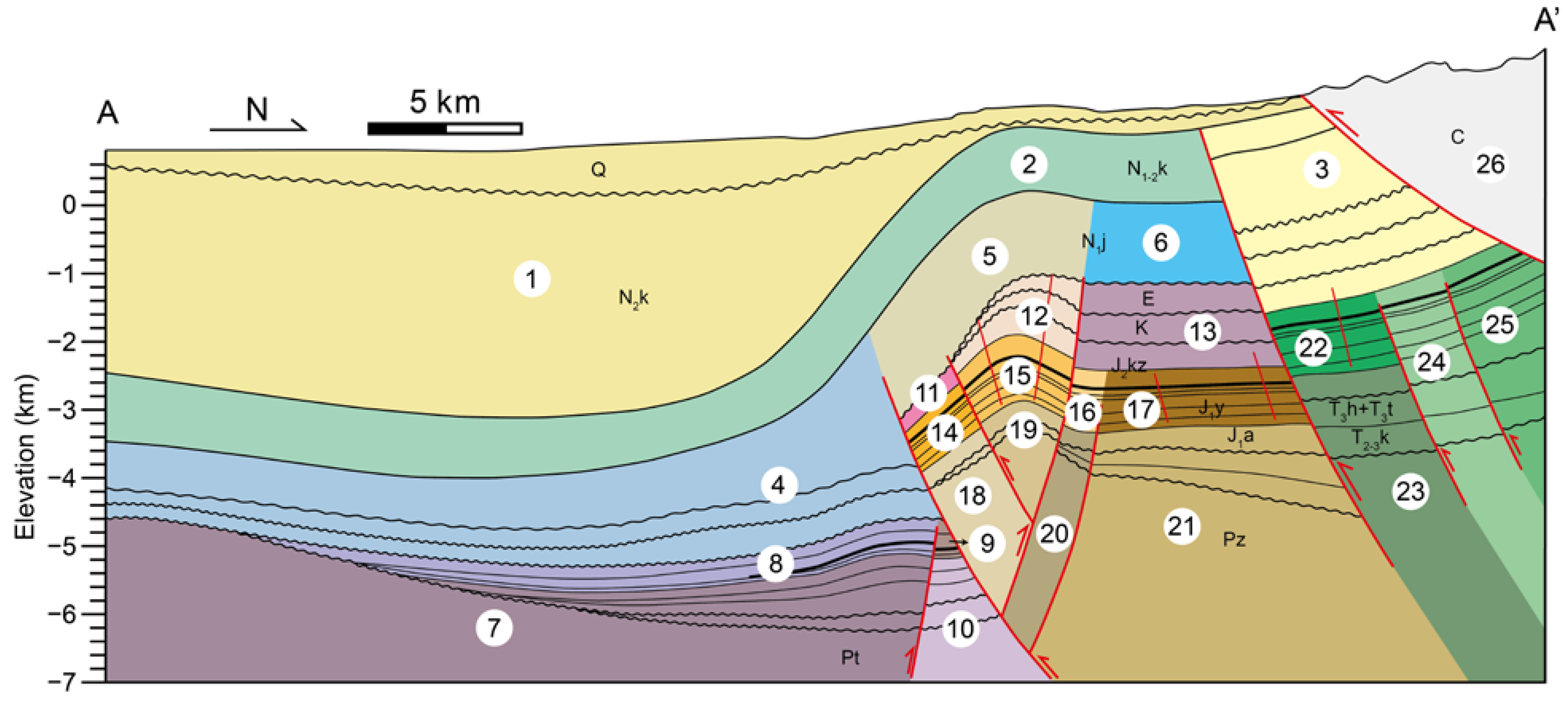

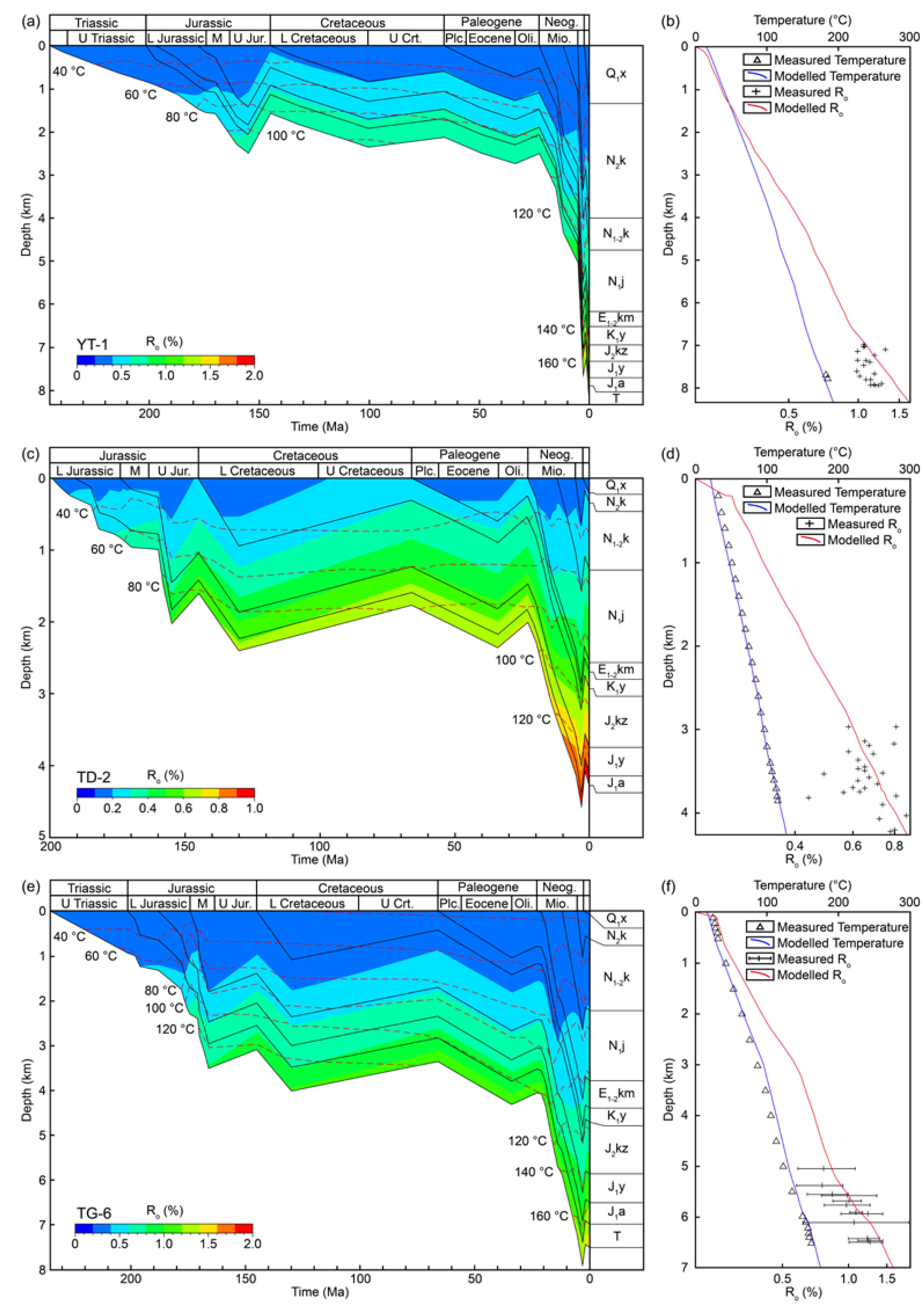
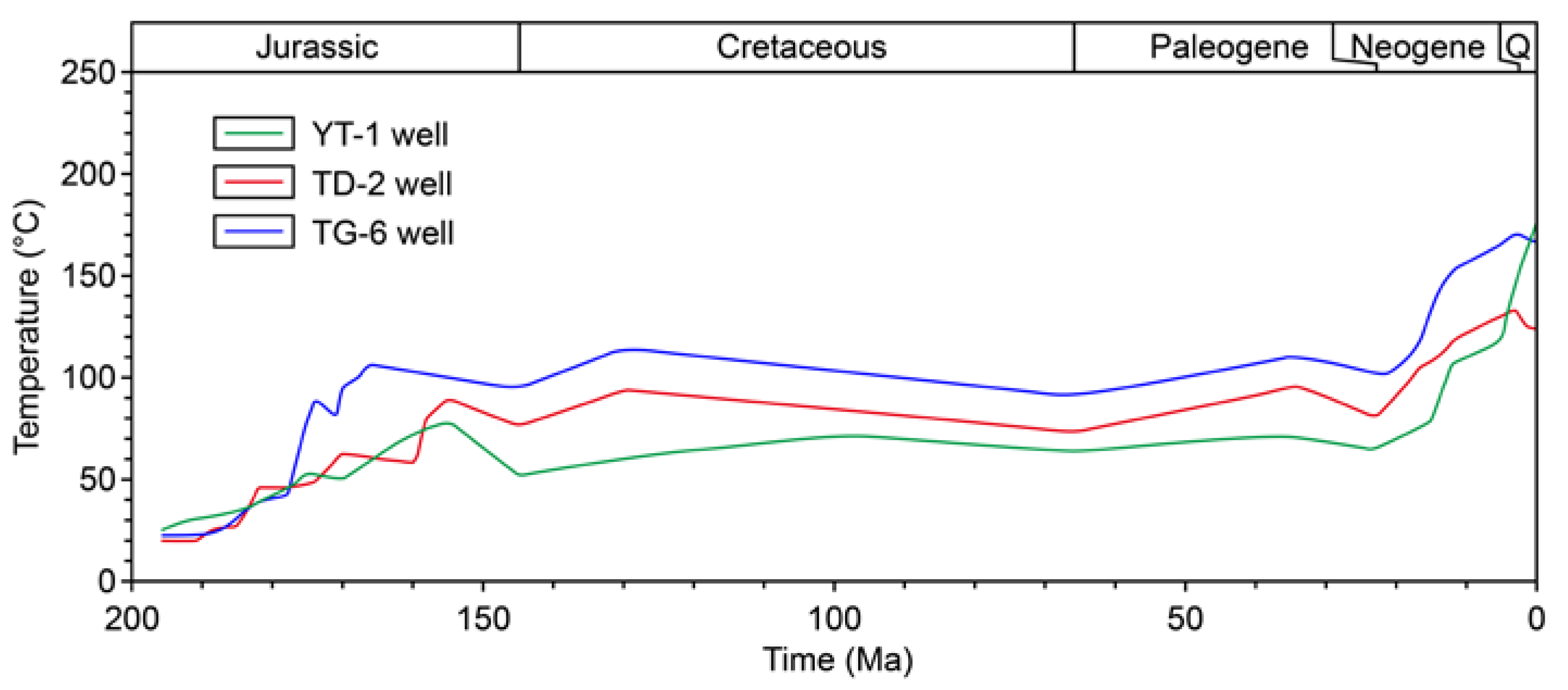
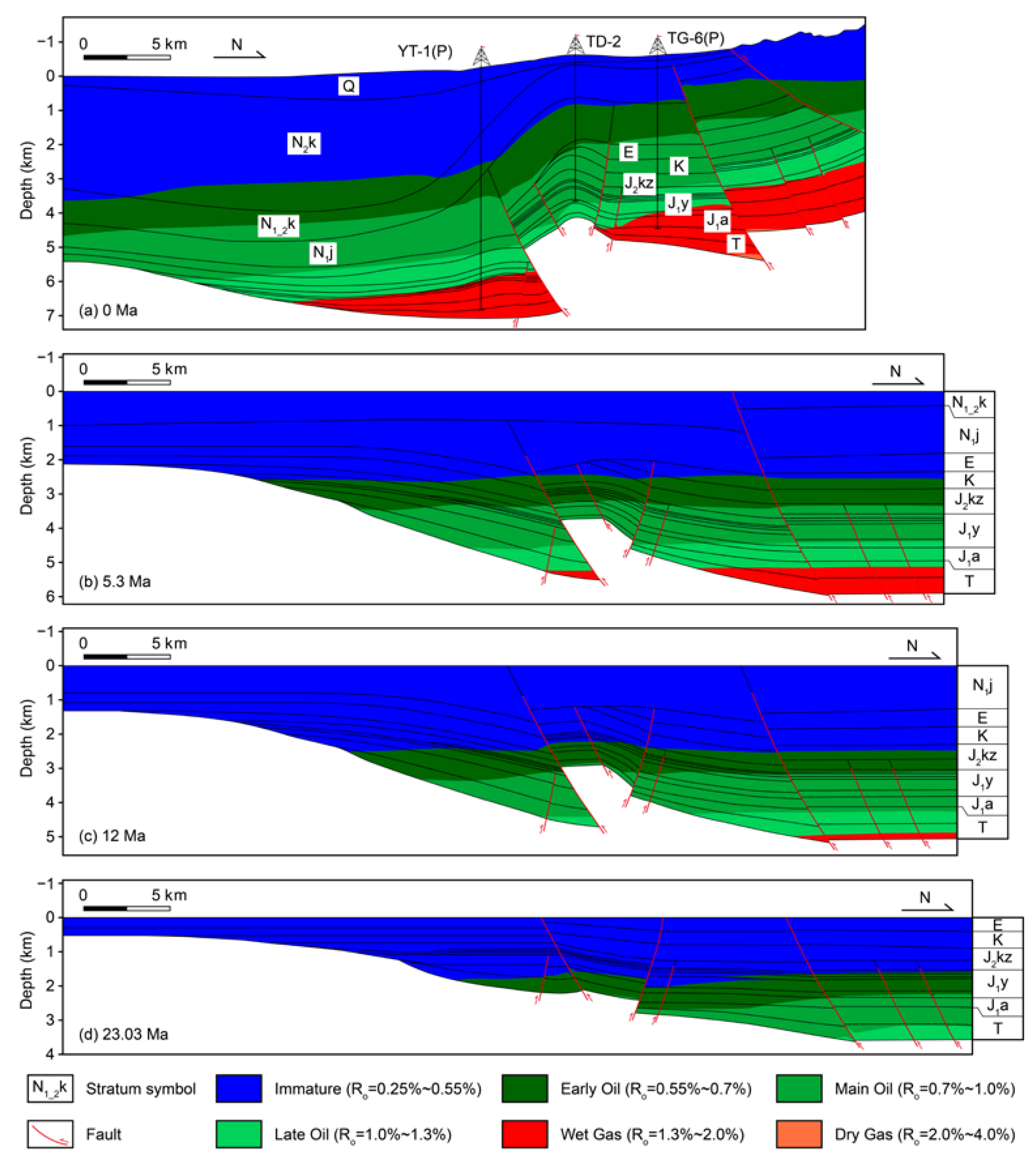
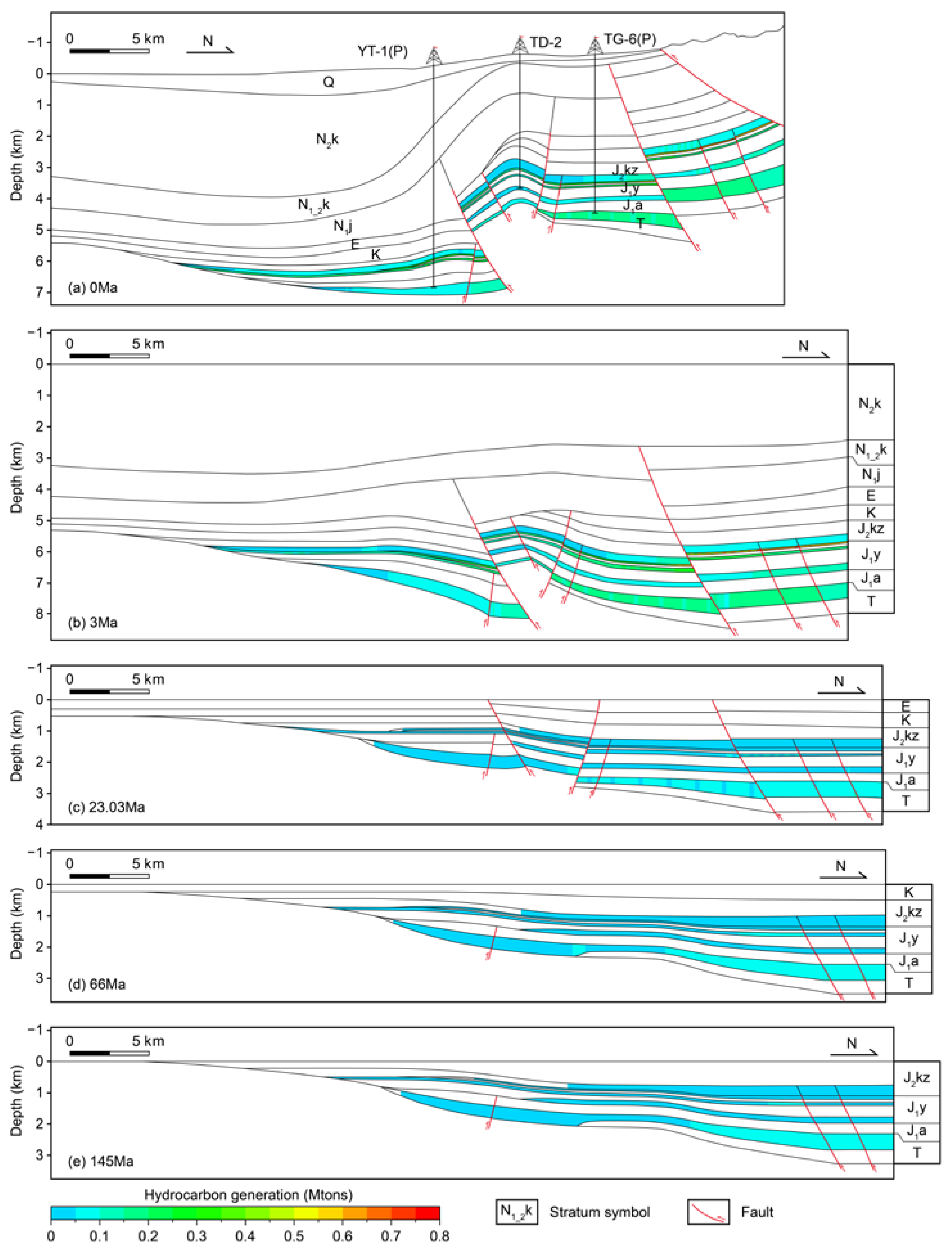
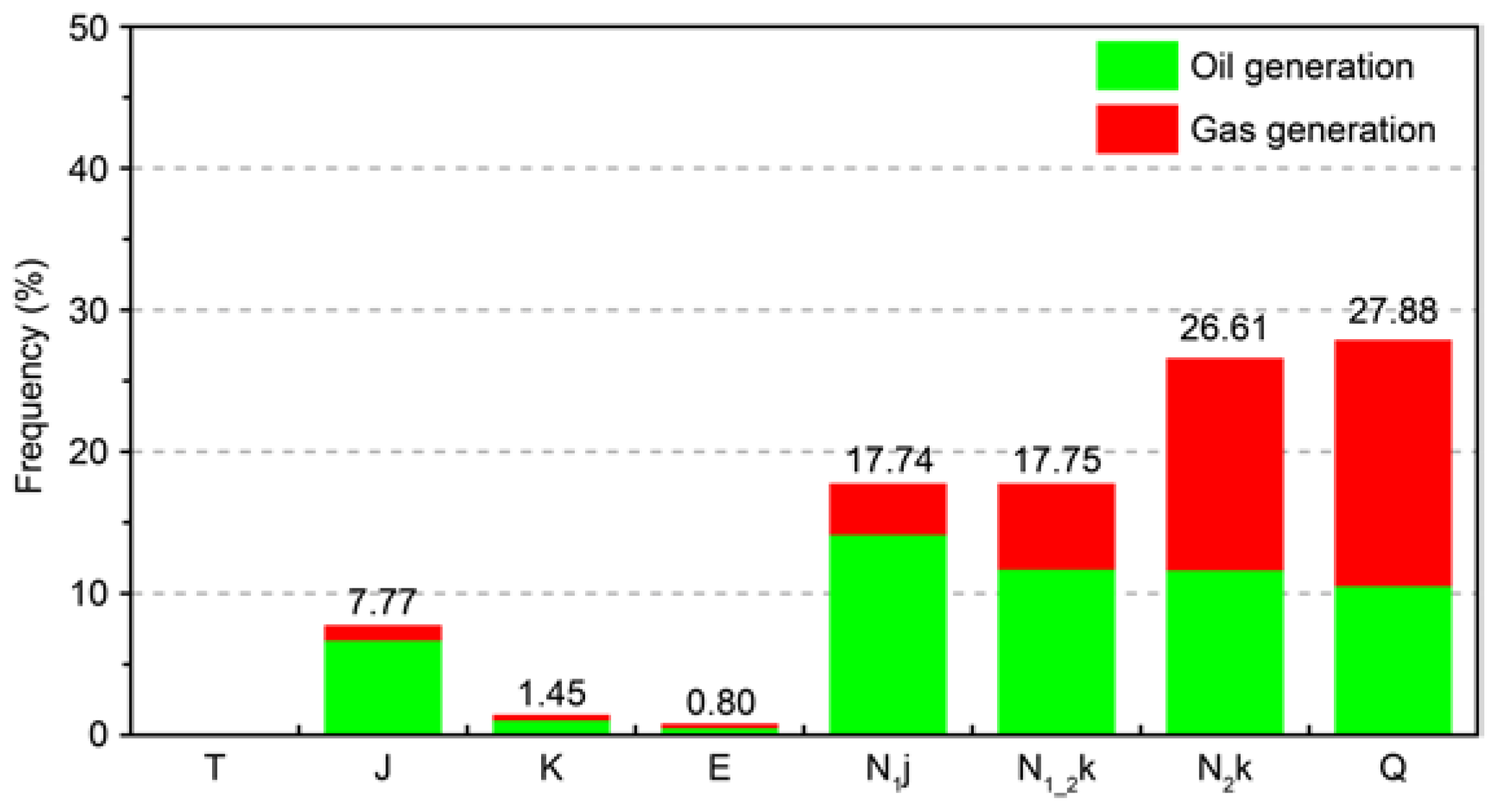
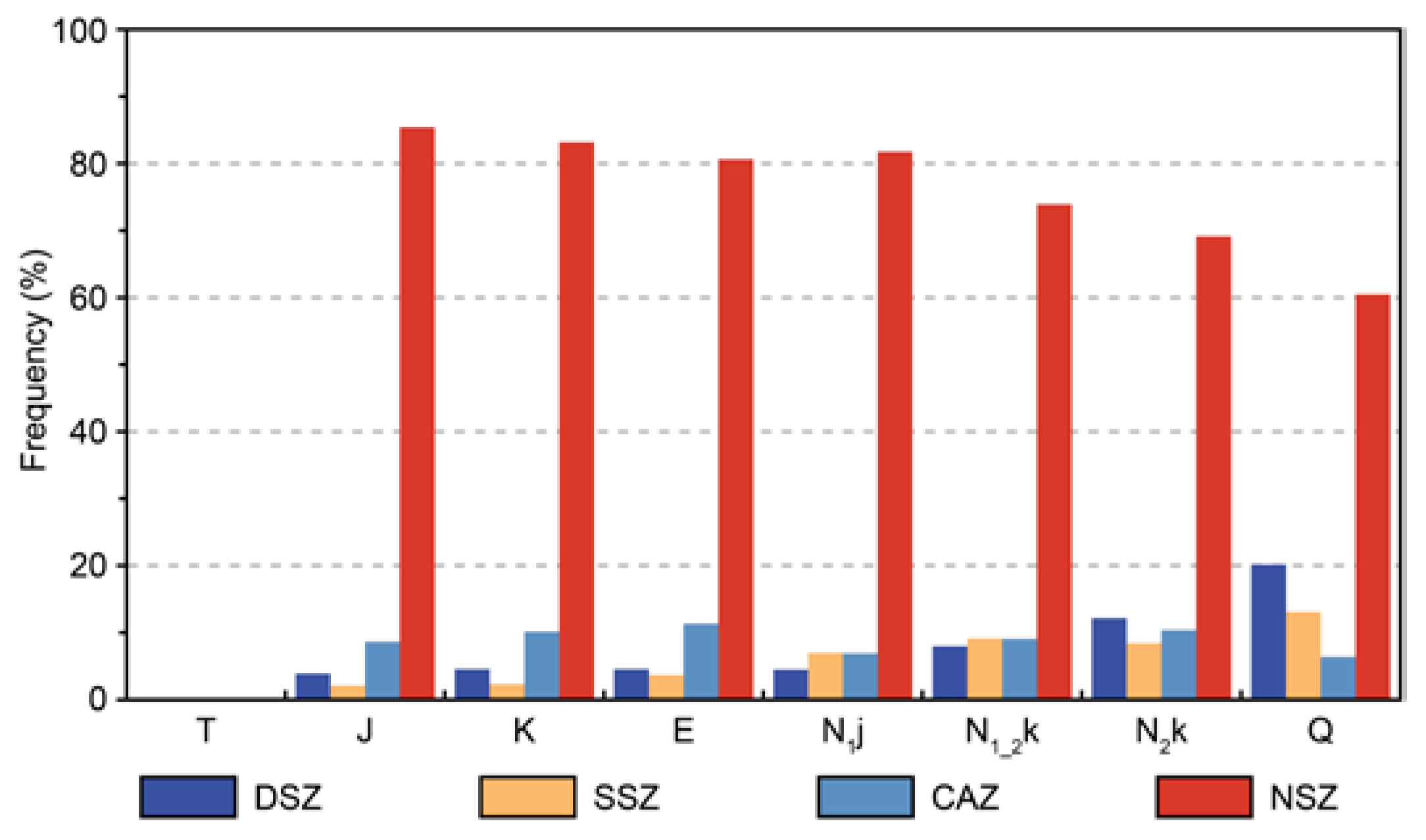
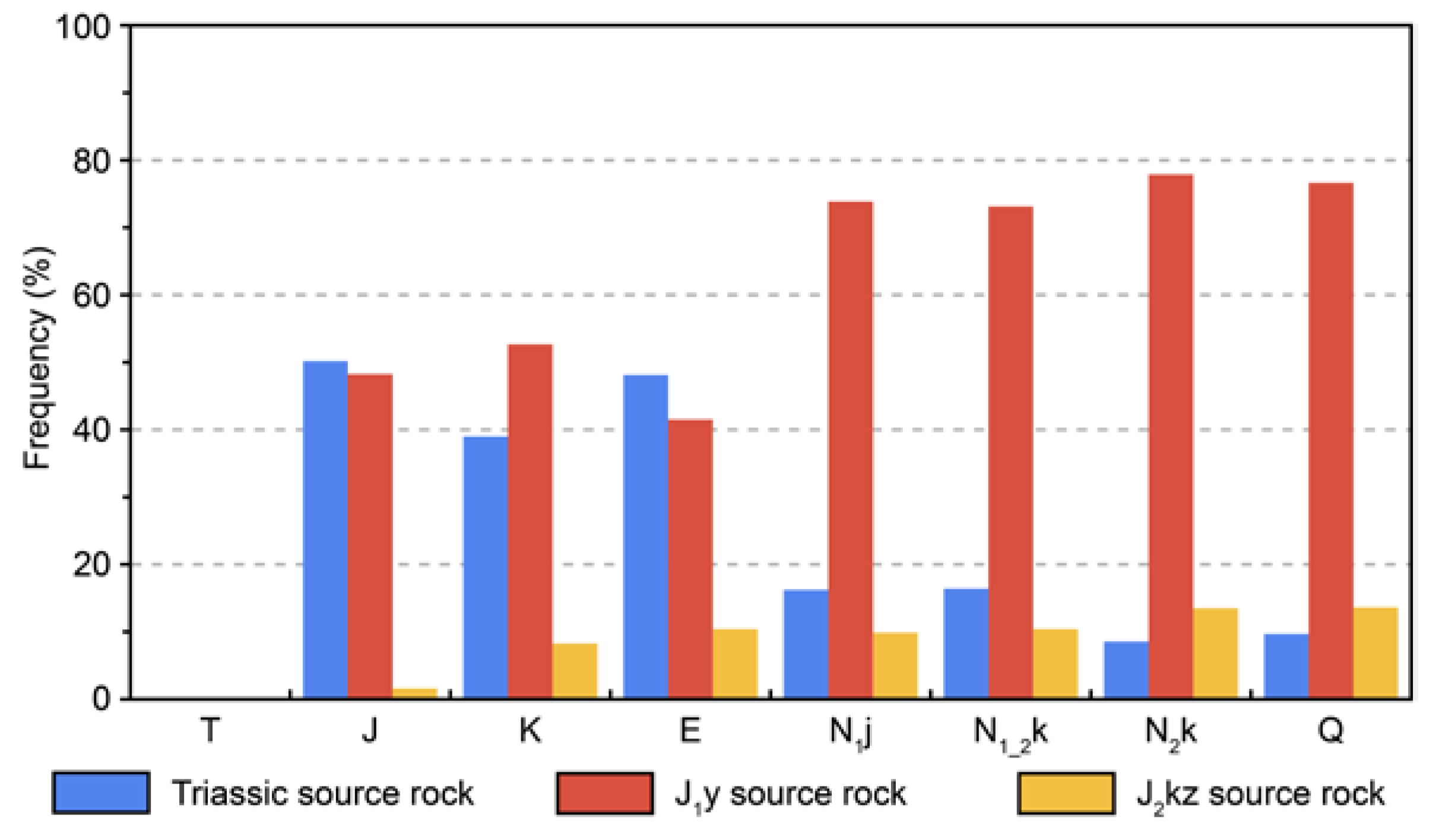

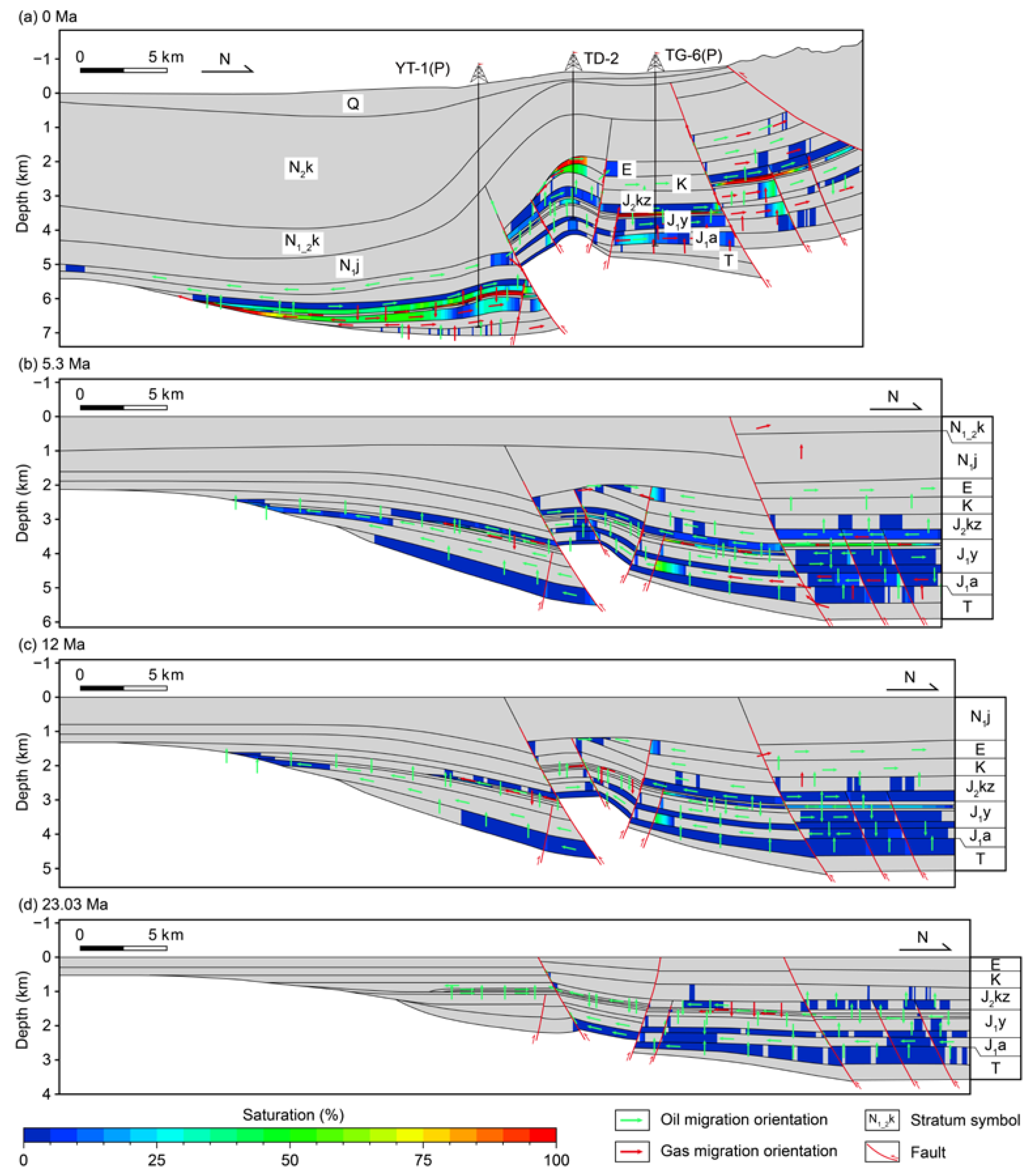
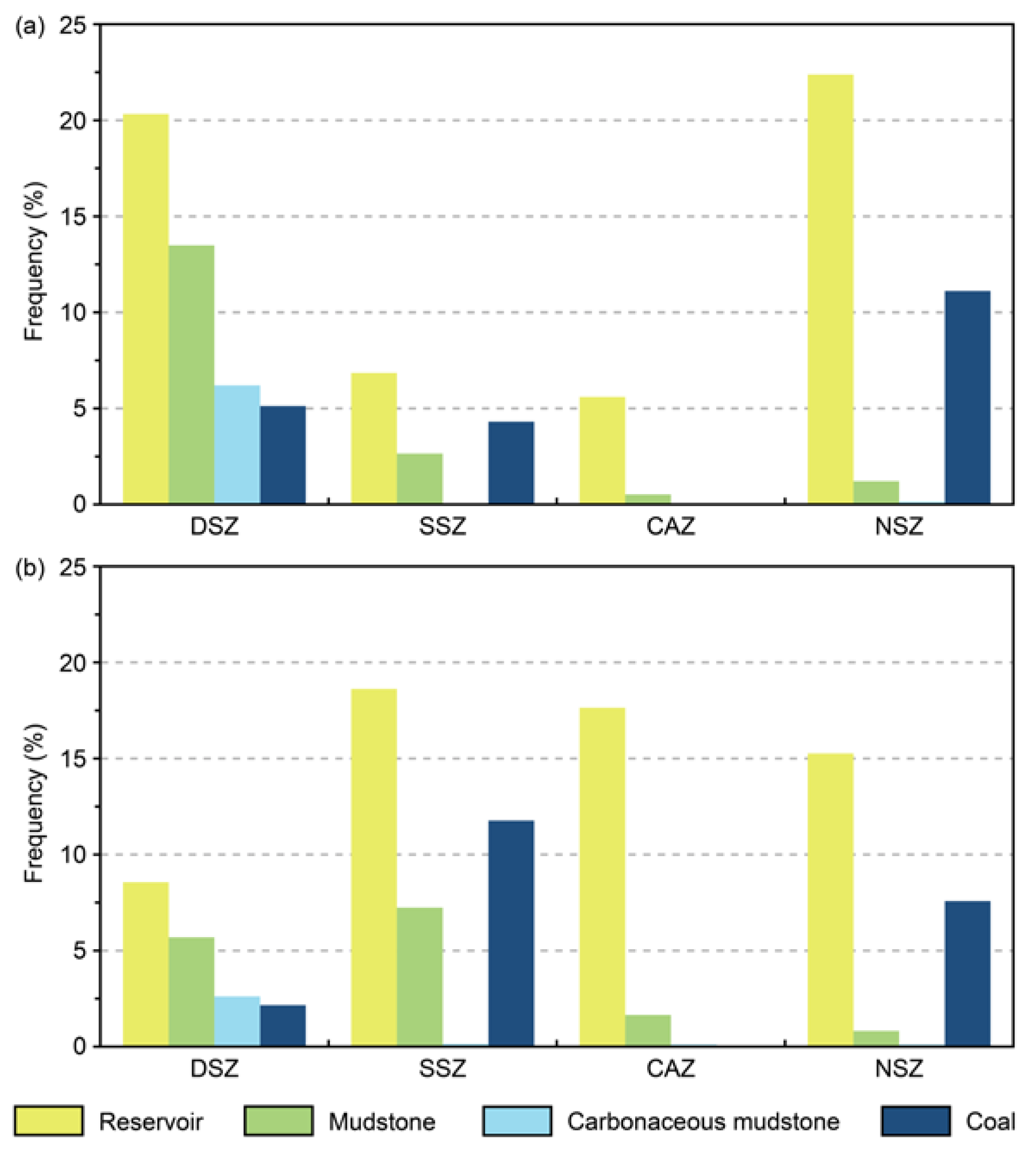
| Formation | Deposition Age | Erosion/Hiatus | Lithology | Petroleum System Element | TOC (%) | HI (mg HC/g TOC) | Kinetics | ||
|---|---|---|---|---|---|---|---|---|---|
| From (Ma) | To (Ma) | From (Ma) | To (Ma) | ||||||
| Q | 1.8 | 0 | Conglomerate (Typical) | Overburden rock | |||||
| N2k | 5.3 | 3 | 3 | 1.8 | Sandstone, Siltstone, Shale | Overburden rock | |||
| N1_2k | 12 | 5.3 | Siltstone, Shale | Overburden rock | |||||
| N1j | 23.03 | 12 | Shale, Siltstone, Gypsum | Seal rock | |||||
| E | 66 | 34 | 34 | 23.03 | Conglomerate, Sandstone | Reservoir rock | |||
| K | 145 | 130 | 130 | 66 | Sandstone, Siltstone | Reservoir rock | |||
| J2kz | 158 | 145 | Shale (Typical) | Seal rock | |||||
| 170 | 158 | Shale (Organic-Rich, Typical) | Source rock | 3 | 200 | Mudstone [12] | |||
| J1y | 175.5 | 170 | Coal (Pure) | Source rock | 55 | 250 | Coal [12] | ||
| 178 | 175.5 | Sandstone (Typical) | Reservoir rock | ||||||
| 178.5 | 178 | Coal (Pure), Shale (Typical) | Source rock | 20 | 200 | C-mudstone [12] | |||
| 182 | 178.5 | Conglomerate, Sandstone | Reservoir rock | ||||||
| 188 | 182 | Shale (Organic-Rich, Typical) | Source rock | 3 | 200 | Mudstone [12] | |||
| J1a | 201.3 | 188 | Conglomerate, Sandstone | Reservoir rock | |||||
| T | 203.5 | 201.3 | Shale (Organic-Rich, Typical) | Source rock | 3 | 200 | Mudstone [12] | ||
| 210 | 203.5 | Conglomerate, Sandstone, Shale | Underburden rock | ||||||
Disclaimer/Publisher’s Note: The statements, opinions and data contained in all publications are solely those of the individual author(s) and contributor(s) and not of MDPI and/or the editor(s). MDPI and/or the editor(s) disclaim responsibility for any injury to people or property resulting from any ideas, methods, instructions or products referred to in the content. |
© 2024 by the authors. Licensee MDPI, Basel, Switzerland. This article is an open access article distributed under the terms and conditions of the Creative Commons Attribution (CC BY) license (https://creativecommons.org/licenses/by/4.0/).
Share and Cite
Jia, K.; Yuan, W.; Liu, J.; Yang, X.; Zhang, L.; Liu, Y.; Zhou, L.; Liu, K. Hydrocarbon Generation and Accumulation in the Eastern Kuqa Depression, Northwestern China: Insights from Basin and Petroleum System Modeling. Appl. Sci. 2024, 14, 1217. https://doi.org/10.3390/app14031217
Jia K, Yuan W, Liu J, Yang X, Zhang L, Liu Y, Zhou L, Liu K. Hydrocarbon Generation and Accumulation in the Eastern Kuqa Depression, Northwestern China: Insights from Basin and Petroleum System Modeling. Applied Sciences. 2024; 14(3):1217. https://doi.org/10.3390/app14031217
Chicago/Turabian StyleJia, Kun, Wenfang Yuan, Jianliang Liu, Xianzhang Yang, Liang Zhang, Yin Liu, Lu Zhou, and Keyu Liu. 2024. "Hydrocarbon Generation and Accumulation in the Eastern Kuqa Depression, Northwestern China: Insights from Basin and Petroleum System Modeling" Applied Sciences 14, no. 3: 1217. https://doi.org/10.3390/app14031217
APA StyleJia, K., Yuan, W., Liu, J., Yang, X., Zhang, L., Liu, Y., Zhou, L., & Liu, K. (2024). Hydrocarbon Generation and Accumulation in the Eastern Kuqa Depression, Northwestern China: Insights from Basin and Petroleum System Modeling. Applied Sciences, 14(3), 1217. https://doi.org/10.3390/app14031217








